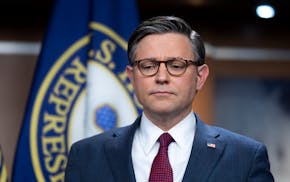When Bill Peterson moved to Coon Rapids in the early 1960s, only three railroad trains passed through the city each day.
Now, he said, it's more like three trains an hour, "Train after train after train." he said.
At a roundtable discussion on rail safety held Monday, Coon Rapids Fire Chief John Piper said the figure is closer to 100 trains a day, with some blocking traffic for up to 25 minutes at a time.
That's not just an inconvenience for motorists. When trains block an intersection for that long, it can affect response times for emergency vehicles that either must wait for the train to clear or detour to longer routes.
The system is broken, Ramsey City Administrator Kurt Ulrich said, and "is not working the way it should be."
The forum, which included city and state leaders, Gov. Mark Dayton and railroad representatives, looked at ways to keep cities and towns across Minnesota safe in the face of dramatically increased rail traffic and oil transport from North Dakota.
Dayton, who held a Governor's Rail Summit last month, now has the state Transportation Department studying the risks of 500 road crossings on railroad tracks that carry oil trains. The goal is to identify the highest-risk intersections, and invest in safety improvements.
Tracking problems
Officials said Monday that a jump in traffic on the BNSF Railway lines has created backups at rail crossings.
BNSF reported last month that up to 39 of its oil trains pass through the Twin Cities per week.
Cities that experience traffic backups blame train staging — when trains pulling into a rail yard slow down or stop in front of the crossing.
"We are stuck at crossings just waiting for trains," Coon Rapids Mayor-elect Jerry Koch said.
It was the main topic of conversation during the hour-and-a-half roundtable.
Piper said he has reached out to BNSF officials, but the problem isn't improving.
The governor asked if there was an alternative to staging trains in Coon Rapids.
BNSF representative Brian Sweeney said the company plans to lay an additional track to help alleviate the problem but said that will take time. He said if trains are staged elsewhere, it just moves the problem to some other city.
Building overpasses or underpasses to allow traffic flow is one option under discussion but an expensive one. Such alternatives could cost up to $50 million per railroad crossing.
Koch said communication between BNSF dispatchers in Fort Worth, Texas, and local engineers is always a problem. Improving coordination within the railroad companies could reduce the congestion of the train traffic, he said.
By the end of the roundtable, Koch said he felt more optimistic.
"Nobody went there expecting a resolution. I think we were hoping for some direction," Koch said. "I don't think there are any short answers."
Dayton said the railroad companies must be responsive to the predicaments caused by increased rail traffic.
"We got to work our way through this together," he said.
Karen Zamora • 612-673-4647
Twitter: @KarenAnelZamora
Finding an apartment may be easier for California pet owners under new legislation
Jury selection could be nearing a close in Donald Trump's hush money trial in New York
